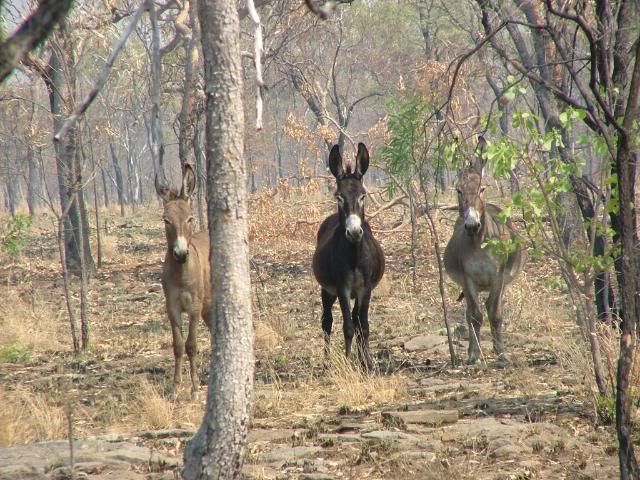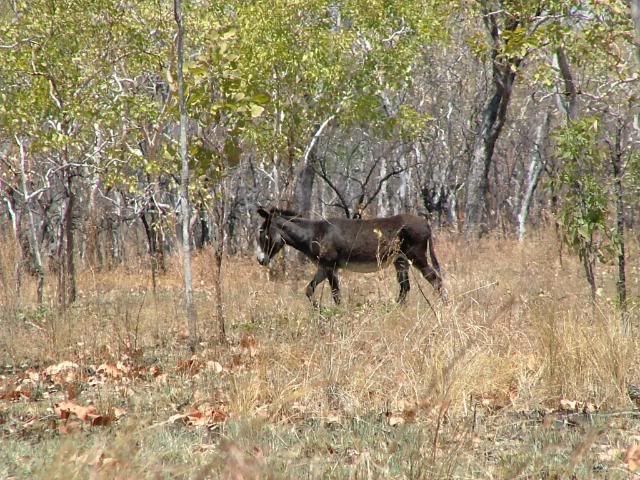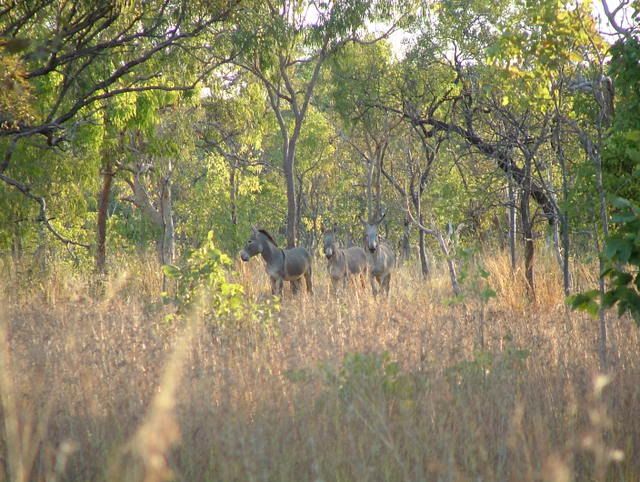Caught-up with an old mate at the pub when I went to town, and got talking about smoke poles. He was pretty curious about them, and so I asked him if he still had a few feral donkeys in the southern end of his cattle station. He sure did, and a few days later, there we were, searching for them in the heat and dust...
Stalked to thirty-five metres of these donkeys eating green shoots in a hollow, and dropped the first one on the spot. The others trotted away a short distance, turned, and started braying at him. I stalked them to about forty-five metres and shot another one in the chest. Meanwhile the first one had arisen slightly, then collapsed again. A ball to the brain finished him. The second one was down and dead in about seventy metres. I believe the first one to have been shot near the spine. The second was shot through the lungs, and we dug the ball out on the offside, as it was bulging out. The .54" roundball is emphatic on donkeys! I was using one-hundred grains of Alliant Black MZ.


Australia has over five-million feral donkeys, and they cause a lot of ecological damage, in addition to competing with livestock for limited grazing. They also destroy Aboriginal sacred sites, by seeking shelter in caves and rubbing against the rock-art and disturbing burial remains. The donkeys (African wild ass) were used in the early pioneering days to carry goods to remote cattle stations and settlements, and when mechanised transport did them out of work, the teamsters cut their donkeys loose. They didn't realise how well they would breed, and how well they would thrive in the Outback. Feral donkeys inhabit huge percentages of the Northern Territory, South Australia and Western Australia. There are also some in Queensland, and there were (maybe still are) some in a pocket of New South Wales. Sure, you can eat them, and dogs can, obviously. But where we are, it's really only Europeans and Asians that eat them. Most of us simply shoot them and leave them for the birds, goannas and wild dogs - because we're culling them, not hunting them for meat.
Here's a photo of some live donkeys:



Stalked to thirty-five metres of these donkeys eating green shoots in a hollow, and dropped the first one on the spot. The others trotted away a short distance, turned, and started braying at him. I stalked them to about forty-five metres and shot another one in the chest. Meanwhile the first one had arisen slightly, then collapsed again. A ball to the brain finished him. The second one was down and dead in about seventy metres. I believe the first one to have been shot near the spine. The second was shot through the lungs, and we dug the ball out on the offside, as it was bulging out. The .54" roundball is emphatic on donkeys! I was using one-hundred grains of Alliant Black MZ.


Australia has over five-million feral donkeys, and they cause a lot of ecological damage, in addition to competing with livestock for limited grazing. They also destroy Aboriginal sacred sites, by seeking shelter in caves and rubbing against the rock-art and disturbing burial remains. The donkeys (African wild ass) were used in the early pioneering days to carry goods to remote cattle stations and settlements, and when mechanised transport did them out of work, the teamsters cut their donkeys loose. They didn't realise how well they would breed, and how well they would thrive in the Outback. Feral donkeys inhabit huge percentages of the Northern Territory, South Australia and Western Australia. There are also some in Queensland, and there were (maybe still are) some in a pocket of New South Wales. Sure, you can eat them, and dogs can, obviously. But where we are, it's really only Europeans and Asians that eat them. Most of us simply shoot them and leave them for the birds, goannas and wild dogs - because we're culling them, not hunting them for meat.
Here's a photo of some live donkeys:












